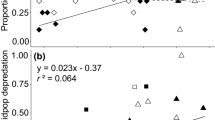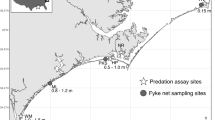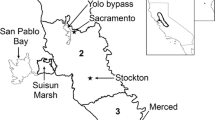Abstract
Context
Movement of prey on hydrologically pulsed, spatially heterogeneous wetlands can result in transient, high prey concentrations, when changes in landscape features such as connectivity between flooded areas alternately facilitate and impede prey movement. Predators track and exploit these concentrations, depleting them as they arise.
Objectives
We sought to describe how prey pulses of fish rapidly form and persist on wetland landscapes, while enduring constant consumption by wading birds, without being fully depleted. Specifically, we questioned how is the predator–prey relationship mediated by interactions between animal movement and dynamic landscape connectivity?
Methods
Two models were developed of the predator–prey-landscape system with qualitatively different representations of space, to identify and quantify prey pulsing dynamics that were robust across modeled assumptions. The first included a homogeneous landscape described by simple geometry, and implicit fish movement as wetland volume contracts. The second modeled transverse movement across a heterogeneous landscape, with isolated drying patches.
Results
Both models produced rapid fish prey concentrations as the wetland dried to shallow water depths. These conditions are critical for making prey available to wading birds. Fish were also rapidly depleted by birds, representing daily caloric intake supporting birds. Model 1 provided average estimates across the modeled domain. Model 2 mapped locations of emerging prey hotspots on the landscape through time.
Conclusions
Our models tracked predator, prey, and landscape dynamics in parallel, inducing systems dynamics from empirical observations. Explicit inclusion of dynamic wetland hydrologic connectivity, a key landscape mechanism, allowed for a comprehensive picture of links between landscape dynamics and the adapted predator–prey system.






Adapted with permission from The Auk. Reference: Kushlan (1976). (Color figure online)


Similar content being viewed by others
References
Agostini VN, Bakun A (2002) Ocean triads’ in the Mediterranean Sea: physical mechanisms potentially structuring reproductive habitat suitability (with example application to European anchovy, Engraulis encrasicolus). Fish Oceanogr 11(3):129–142
Bakun A (2006) Wasp-waisted populations in marine ecosystem dynamics: navigating the “predator pit” topographies. Prog Oceanogr 68:271–288
Bancroft GT, Strong AM, Sawicki RJ, Hoffman W, Jewell SD (1994) Relationship among wading bird foraging patterns, colony locations, and hydrology in the Everglades. In: Davis SM, Ogden JC (eds) Everglades, the ecosystem and its restoration. Lucie Press, Delray Beach, pp 615–657
Bayley PB (1991) The flood pulse advantage and the restoration of river-floodplain systems. Regul Rivers Res Manag 6:75–86
Beerens JM, Gawlik DE, Herring G, Cook MI (2011) Dynamic habitat selection by two wading bird species with divergent foraging strategies in a seasonally fluctuating wetland. Auk 128(4):651–662
Beerens JM, Noonburg EG, Gawlik DE (2015) Linking dynamic habitat selection with wading bird foraging distributions across resource gradients. PLoS ONE 10(6):e0128182
Botson BA, Gawlik DE, Trexler JC (2016) Mechanisms that generate resource pulses in a fluctuating wetland. PLoS ONE. https://doi.org/10.1371/journal.pone.0158864
Box GE (1976) Science and statistics. J Am Stat Assoc 71(356):791–799
Calabrese JM, Fagan WF (2004) A comparison–shopper’s guide to connectivity metrics. Front Ecol Environ 2(10):529–536
Davis SM, Gunderson LH, Park WA, Richardson J, Mattson J (1994) Landscape dimension, composition, and function in a changing Everglades ecosystem. In: Davis SM, Ogden JC (eds) Everglades, the ecosystem and its restoration. Lucie Press, Delray Beach, pp 419–444
Deacy W, Leacock W, Armstrong JB, Stanford JA (2016) Kodiak brown bears surf the salmon red wave: direct evidence from GPS collared individuals. Ecology 97(5):1091–1098
Dorn NJ, Cook MI (2015) Hydrological disturbance diminishes predator control in wetlands. Ecology 96:2984–2993
Fleming DM, Wolff WF, DeAngelis DL (1994) Importance of landscape heterogeneity to wood storks in Florida Everglades. Environ Manag 18(5):743–757
Frederick P, Gawlik DE, Ogden JC, Cook MI, Lusk M (2009) The White Ibis and Wood Stork as indicators for restoration of the everglades ecosystem. Ecol Indic 9(6):S83–S95
Frederick PC, Ogden JC (2001) Pulsed breeding of long-legged wading birds and the importance of infrequent severe drought conditions in the Florida Everglades. Wetlands 21(4):484–491
Gaff H, DeAngelis DL, Gross LJ, Salinas R, Shorrosh M (2000) A dynamic landscape model for fish in the Everglades and its application to restoration. Ecol Model 127(1):33–52
Gawlik DE (2002) The effects of prey availability on the numerical response of wading birds. Ecol Monogr 72:329–346
Goodwin BJ (2003) Is landscape connectivity a dependent or independent variable? Landscape Ecol 18(7):687–699
Goodwin BJ, Fahrig L (2002) How does landscape structure influence landscape connectivity? Oikos 99:552–570
Goss CW, Loftus WF, Trexler JC (2014) Seasonal fish dispersal in ephemeral wetlands of the Florida Everglades. Wetlands 34(1):147–157
Gunderson LH, Loftus WF (1993) The Everglades. In: Martin WH, Boyce SG, Echternacht AC (eds) Biodiversity of the Southeastern United States: lowland terrestrial communities. John Wiley & Sons Inc, New York, pp 199–255
Hoch JM, Sokol ER, Parker AD, Trexler JC (2015) Migration strategies vary in space time, and among species in the small-fish metacommunity of the Everglades. Copeia 103(1):157–169
Johnson WC, Werner B, Guntenspergen GR, Voldseth RA, Millett B, Naugle DE, Tulbure M, Carroll RW, Tracy J, Olawsky C (2010) Prairie wetland complexes as landscape functional units in a changing climate. Bioscience 60(2):128–140
Jones J, U.S. Geological Survey (2011) Everglades Depth Estimation Network (EDEN) October 2011 Digital Elevation Model (DEM)
Junk WJ, Bayley PB, Sparks RE (1989) The flood pulse concept in river–floodplain systems. Can Spec Publ Fish Aquat Sci 106(1):110–127
Kahl MP (1964) Food ecology of the wood stork (Mycteria americana) in Florida. Ecol Monogr 34(2):98–117
Kauffman MJ, Varley N, Smith DW, Stahler DR, MacNulty DR, Boyce MS (2007) Landscape heterogeneity shapes predation in a newly restored predator–prey system. Ecol Lett 10(8):690–700
Klassen JA, Gawlik DE, Frederick PC (2016) Linking wading bird prey selection to number of nests. J Wildl Manag 80(8):1450–1460
Kushlan JA (1973) An ecological study of an Alligator Pond in the Big Cypress Swamp of southern Florida. M.S Thesis. University of Miami
Kushlan JA (1974) Effects of a natural fish kill on the water quality, plankton, and fish population of a pond in the Big Cypress Swamp, Florida. Trans Am Fish Soc 103(2):235–243
Kushlan JA (1976) Wading bird predation in a seasonally fluctuating pond. Auk 93(3):464–476
Kushlan JA (1986). Responses of wading birds to seasonally fluctuating water levels: strategies and their limits. Colon Waterbirds, pp 155–162
Kushlan JA, Ogden JC, Higer AL (1975) Relation of water level and fish availability to wood stork reproduction in the Southern Everglades, Florida. Rep. 75-434, US Geological Survey, Tallahassee, FL. Liston SE. 2006. Interactions between nutrient availability and hydroperiod shape macroinvertebrate communities in Florida Everglades marshes. Hydrobiologia 569:343–357
MATLAB and Statistics Toolbox Release (2016) The MathWorks, Inc., Natick, Massachusetts, United States
Middleton BA (ed) (2002) Flood pulsing in wetlands: restoring the natural hydrological balance. Wiley, New York
Norris K, Johnstone I (1998) The functional response of oystercatchers (Haematopus ostralegus) searching for cockles (Cerastoderma edule) by touch. J Anim Ecol 67(3):329–346
Obaza A, DeAngelis DL, Trexler JC (2011) Using data from an encounter sampler to model fish dispersal. J Fish Biol 78:495–513
Odum EP (1969) The strategy of ecosystem development. Science 164:262–270
Odum WE, Odum EP, Odum HT (1995) Nature’s pulsing paradigm. Estuaries 18(4):547–555 Papers from William E. Odum Memorial Symposium (Dec., 1995)
Ogden JC (1994) A comparison of wading bird nesting colony dynamics (1931-1946 and 1974-1989) as an indication of ecosystem conditions in the Southern Everglades. In: Davis SM, Ogden JC (eds) Everglades, the ecosystem and its restoration. Lucie Press, Delray Beach, pp 533–570
Ostfeld RS, Keesing F (2000) Pulsed resources and community dynamics of consumers in terrestrial ecosystems. Trends Ecol Evol 15(6):232–237
Poff NL, Allan JD, Bain MB, Karr JR, Prestegaard KL, Richter BD, Sparks RE, Stromberg JC (1997) The natural flow regime. Bioscience 47:769–784
Ruetz CR, Trexler JC, Jordan F, Loftus WF, Perry SA (2005) Population dynamics of wetland fishes: spatio-temporal patterns synchronized by hydrological disturbance? J Anim Ecol 74:322–332
Swanson GA, Duebbert HF (1989) Wetland habitats of waterfowl in the prairie pothole region. Northern Prairie Wetlands. Iowa State University Press, Ames, pp 228–267
Tiner RW (2003) Geographically isolated wetlands of the United States. Wetlands 23(3):494–516
Tischendorf L, Fahrig L (2000) How should we measure landscape connectivity? Landscape Ecol 15(7):633–641
Tockner K, Stanford JA (2002) Riverine flood plains: present state and future trends. Environ Conserv 29(03):308–330
Trexler JC, Loftus WF, Jordan F, Chick JH, Kandl KL, McElroy TC, Bass OL Jr (2002) Ecological scale and its implications for freshwater fishes in the Florida Everglades. In: Porter JW, Porter KG (eds) The Everglades, Florida Bay, and coral reefs of the Florida keys: an ecosystem sourcebook. CRC Press, Boca Raton, pp 53–181
U.S. Geological Survey, National Water Information System (2017). https://waterdata.usgs.gov/nwis/inventory?<agency_code=USGS&site_no=02288900>
van Gils JA, Spaans B, Dekinga A, Piersma T (2006) Foraging in a tidally structured environment by red knots (Calidris canutus): ideal but not free. Ecology 87(5):1189–1202
White TCR (2005) Why does the world stay green: nutrition and survival of plant-eaters. CSIRO Publishing, Collingwood
Wolff WF (1994) An individual-oriented model of a wading bird nesting colony. Ecol Model 72(1):75–114
Yang LH, Bastow JL, Spence KO, Wright AN (2008) What can we learn from resource pulses. Ecology 89(3):621–634
Yurek S, DeAngelis DL, Trexler JC, Jopp F, Donalson DD (2013) Simulating mechanisms for dispersal, production and stranding of small forage fish in temporary wetland habitats. Ecol Model 250:391–401
Yurek S, DeAngelis DL, Trexler JC, Klassen JA, Larsen LG (2016) Persistence and diversity of directional landscape connectivity improves pulsed energy transfers in dynamic oligotrophic wetlands. Ecol Complex 28:1–11.
Acknowledgements
We thank the editors of The Auk for permission to reprint results from Kushlan (1976), and Gus Engman and four anonymous reviewers for their generous time and contributions. This work was supported by The USGS’s Greater Everglades Priority Ecosystem Science and the U.S. Fish and Wildlife Service. Any use of trade, firm, or product names is for descriptive purposes only and does not imply endorsement by the U.S. Government.
Author information
Authors and Affiliations
Corresponding author
Additional information
Publisher's Note
Springer Nature remains neutral with regard to jurisdictional claims in published maps and institutional affiliations.
Electronic supplementary material
Below is the link to the electronic supplementary material.
Rights and permissions
About this article
Cite this article
Yurek, S., DeAngelis, D.L. Resource concentration mechanisms facilitate foraging success in simulations of a pulsed oligotrophic wetland. Landscape Ecol 34, 583–601 (2019). https://doi.org/10.1007/s10980-019-00784-0
Received:
Accepted:
Published:
Issue Date:
DOI: https://doi.org/10.1007/s10980-019-00784-0




